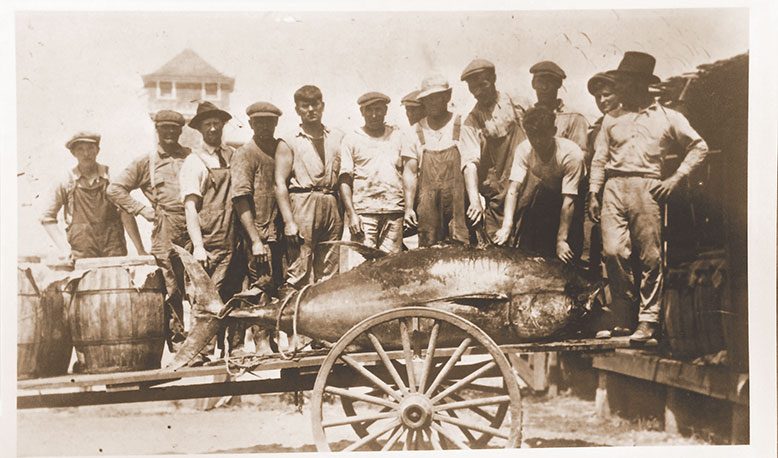
Though hardly as glamorous as today’s resort industry, pound fishing—which trapped large quantities of fish in massive nets—was a major part of the Jersey Shore economy from the mid-19th through the mid-20th century.
Pound fisherman used a series of nets attached to wooden poles to trap their catch. The poles—some as long as 70 feet—were driven into the ocean floor about a half mile from the shore, creating a permanent structure in a shape resembling an arrow. When fish entered the open end of the pound structure, they were corralled by the nets and funneled into a netting bag, which could be raised to the surface. Once on the surface, the netting bag was loaded onto a skiff and pulled ashore by horses, and later, tractors and beach buggies. The fish were sorted, packed on ice and shipped by rail to the Fulton Fish Market in New York City or Dock Street Market in Philadelphia.
This style of fishing was originally adopted by Canadians, who learned it from Native Americans. Its use spread from Nova Scotia to the Carolinas and west to the Great Lakes. Pound fishing arrived in New Jersey in the 1850s; by the turn of the century, the state’s pound-fishing industry was one of the largest and most lucrative in North America. In 1914, the New Jersey Courier reported that the 128 licensed fish pounds along the Jersey coast employed 605 men and scooped up more than 34 million pounds of fish, bringing in $773,137.
Pound fishermen hauled in more than 30 species of fish, including bluefish, cod, sunfish, tuna, sharks and herring. The season started in early March, when storm-damaged cedar and hickory poles were replaced, and ran through November.
Locals and visitors alike would gather on Jersey’s beaches in places like Bay Head, Mantoloking, Lavallette and Seaside Heights as the skiffs were dragged ashore by huge Clydesdales two to three times a day. Crowds were enticed by stories of a particularly large catch or a mishap at sea.
New pound fisheries were still opening in the 1930s, but the technique slowly gave way to modern seagoing methods. After four years of poor fishing, plus a series of devastating nor’easters in the early 1950s, the industry went under altogether.




My granddad was part of this. He made the first journey from Norway to the U.S. in 1906 (he was seventeen) and stayed for six years. Hoboken was like a home to him. He made another trip some years later before going back to Norway for good, building a home and starting a family. In 1970, a local author did a several hour long interview with my granddad. I have it on a tape. In that interview he tells a lot of stories from his years working as a fisherman in NJ, including technical descriptions about nets, poles, boats, engines and much more.